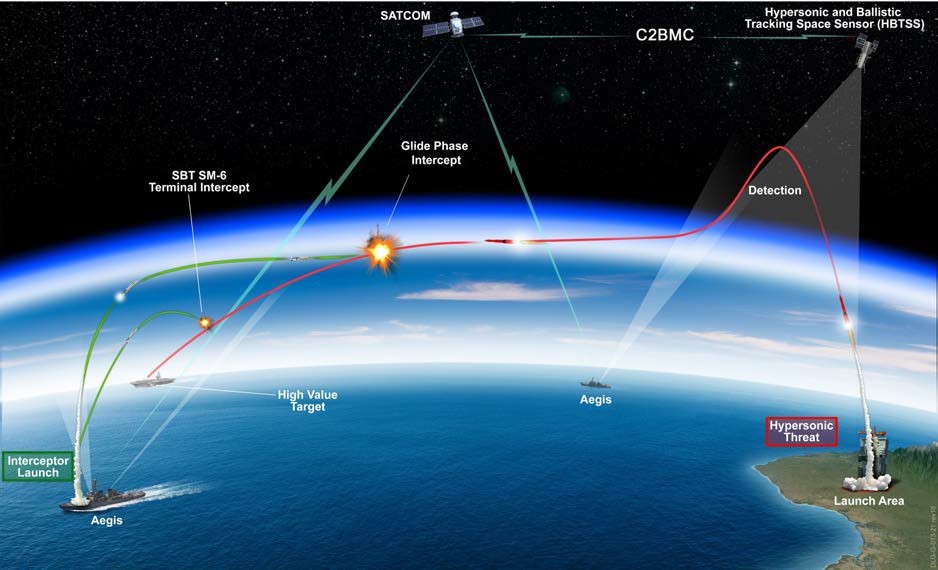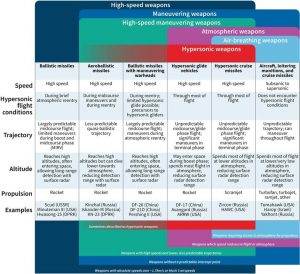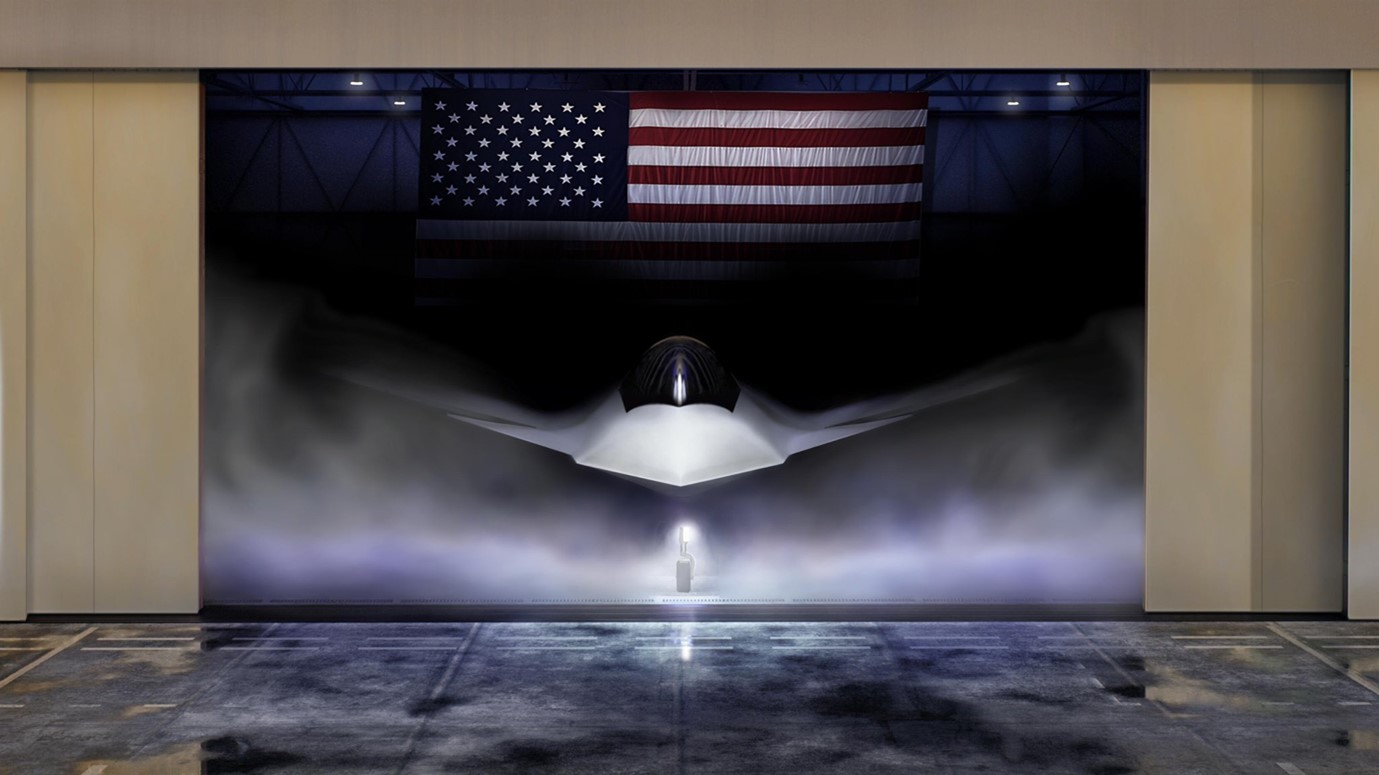
COUNTERING HYPERSONIC WEAPON THREAT: A DIFFICULT BUT MANAGEABLE PROBLEM

Introduction
Decades ago, ballistic missile defence was developed to intercept predictable targets outside the atmosphere. Since then, the missile threat spectrum has broadened, becoming more endo-atmospheric and manoeuvrable. Hypersonic weapons, a new breed of threat, combine the speed and range of ballistic missiles with a cruise missile’s low-altitude and manoeuvrable flight profile. Defending against hypersonic missiles is not just necessary; it’s a complex and formidable challenge that demands new designs, capabilities, and operational concepts.
While finding a technologically possible and fiscally affordable solution isn’t easy, it’s crucial to recognise that existing defence frameworks, despite not explicitly designed for hypersonic threats, hold significant potential to counter them. This potential should inspire a new way of thinking and a different approach from those employed for legacy ballistic and cruise missile defence systems. The characteristics that make hypersonic missiles attractive may also be the key to defeating them. Instead of thinking about hypersonic defence as an adjunct to the legacy ballistic missile defence, it will be better to learn from it and develop new defence capabilities, with a mix of active and passive measures, to meet the new challenges.
Attributes & Challenges
Hypersonic weapons, with their staggering speed over Mach 5, or five times the speed of sound, are a force to be reckoned with. They are not just fast; they are agile. While they are often categorised into two types—hypersonic glide vehicles and hypersonic cruise missiles—this classification fails to capture the true diversity of the hypersonic missile threat spectrum. It’s not just about speed. Long-range ballistic missiles can reach similar or greater speeds as they re-enter the atmosphere. What sets hypersonic weapons apart is their ability to sustain these speeds at altitudes below those of most ballistic missiles and, most importantly, their maneuverability. They operate at altitudes below 100 km, where space is often said to begin, and typically around 20 to 60 km, above the ceilings of most aircraft and cruise missiles. This unique combination of high speed, lower altitude, and maneuverability makes it incredibly difficult to predict the trajectories of hypersonic weapons, especially with terrestrial sensors, posing a significant challenge to the existing defence systems.

Source: CSIS Missile Defense Project
At speeds around Mach 5, flying objects encounter thermal and aerodynamic phenomena distinct from those experienced in supersonic and exo-atmospheric flight. These phenomena involve extreme temperatures and aero-thermal interactions on the vehicle surface. Of particular importance are the remarkable amounts of flow friction and viscous dissipation encountered by the hypersonic vehicle, which leads to substantial temperature increases, the dissociation and ionisation of surrounding gases, and the formation of plasmas. Hypersonic weapons must survive this environment for a sustained period, which poses a unique and significant challenge.
Vulnerabilities
The phenomena of sustained hypersonic flight offer specific vulnerabilities. Some of the same characteristics that make advanced hypersonic missiles desirable present opportunities that could be exploited. Each feature that gives hypersonic weapons an advantage comes with a cost. Extended flight through the atmosphere may expose them to new failure modes.
• Their ability to manoeuvre comes at the cost of expending energy and range.
• Hypersonic weapons experience challenging aero-thermal conditions that strain the limits of current guidance, control, and materials technologies.
• After Re-entering the atmosphere, the hypersonic glide vehicle experiences extreme pressures, vibrations, and temperatures. The vehicle’s surrounding atmosphere dissociates into a plasma in such an environment, reacting violently with the airframe’s surface.
• Ensuring reliable performance in this environment often requires exotic materials and highly integrated designs, especially for higher speeds.
• Minor alterations in the basic shape or weight distribution in a hypersonic vehicle’s airframe, for instance, can have downstream effects on thermal and propulsion system performance and accuracy.
• Hypersonic systems are challenging to design and operate partly because their performance variables are closely coupled.
Defence Is Possible
Hypersonic missiles are not invincible. They are not the ultimate threat. Hypersonic missile defence is not only possible, but it’s also within reach. However, achieving it requires a fresh perspective on existing defence designs and a willingness to approach the problem differently. Hypersonic weapons have certain limitations that ballistic and cruise missiles do not. By targeting the specific characteristics of hypersonic flight, one can break the problem into manageable portions. Just as ballistic missile defence was oriented around the predictability of a ballistic trajectory, the hypersonic defence can also be tailored to the vulnerabilities of the hypersonic flight regime, offering a glimmer of hope in the face of this evolving threat.
The characteristic challenges of hypersonic flight raise intriguing possibilities for a defence system. By definition, hypersonic gliders expend energy while performing manoeuvres. A defence design that encourages manoeuvres early can often exploit those actions’ cost. Moreover, the severe conditions of hypersonic flight—the risk of boundary layer transition and the need for shock wave management—create vulnerabilities that different kill mechanisms can exploit. Minor impacts or perturbations may disrupt hypersonic weapons to their structure or surrounding airflow.
Defence System Architecture
These systems must employ multiple defeat mechanisms, such as kinetic effectors, electronic warfare, and various classes and types of directed-energy systems.
Space-Based Sensors. A vital element for a hypersonic defence program is a resilient and persistent space sensor layer capable of observing, classifying, and tracking missile threats of all types, azimuths, and trajectories. Elevated sensors are necessary to resolve surface-based systems’ range and mobility challenges. Space-based sensors would enable a “launch to impact” tracking capability. Such a capability would be critical for disrupting or defeating hypersonic weapons early in flight, where interception is easier and follow-up shots are possible. The information from those sensors must be fused into a single picture to identify how many missiles have been launched, where they are, and where they are going, all necessary information for defeating them.
Interception. The second most crucial element is the glide-phase interception. Engaging hypersonic threats earlier in flight will be necessary for area defence rather than point defence. A comprehensive, integrated and layered approach would be beneficial. Direct hit interceptors would have to be supplemented and integrated with wide area measures, including high-powered microwave systems and other means to target vulnerabilities of the hypersonic flight regime. Loitering airborne platforms carrying interceptors, sensors, or alternative kill mechanisms could also increase a defensive system’s range. Kinetic interceptors benefit from being launched at higher altitudes, conserving the disproportionate amount of fuel needed to accelerate from the surface and through the thicker lower atmosphere. Multiple aircraft or unmanned platforms would be required to maintain continuous coverage.
Twenty-First Century Flak. Defence against highly manoeuvring hypersonic missiles may require wide area defences. Here, “layered defence” differs from the legacy concept of a linear interception sequence. Other layers or kill mechanisms do not merely catch what a previous layer missed but cumulatively stack together to degrade a given threat. Instead of relying only on a fast, single-purpose interceptor with a highly agile kill vehicle, interceptors with alternative payloads may be able to present hypersonic weapons with multiple challenges together. One such possibility is a twenty-first-century version of “dust defence.” Missiles or airborne platforms could dispense particulate matter to disrupt or destroy hypersonic weapons. At hypersonic velocities, missile impact against atmospheric dust, rain, and other particles can encounter bullet-like kinetic energies, triggering unpredictable aerodynamic, thermal, and structural disruptions.
Directed Energy Weapons. Directed-energy systems offer another alternative to tackle hypersonic attacks. Unlike kinetic weapons, directed-energy weapons may offer large magazine capacities, significantly lower cost per shot, and more straightforward guidance requirements. Although limited mainly by their direct line of sight, directed-energy systems may be suited for augmenting terminal defences or basing close to adversary launch positions. The prospect of using lasers for hypersonic defence has been the subject of considerable debate. Recent technical advances promise significant beam power increases with smaller size, weight, and power demands.
High-powered Microwave (HPM). These weapons represent another directed-energy option for hypersonic defence. High-powered microwave weapons could exploit vulnerabilities in hypersonic weapons’ communications systems and radiation shielding to achieve mission kill. Depending on the extent of damage, a microwave weapon could achieve complete or partial mission kill, disrupting a vehicle’s ability to navigate, arm its warhead, or maintain level flight. Microwave radiation can enter a hypersonic weapon through antennae operating at the same frequency as other unshielded vehicle elements, damaging internal electronics. HPMs are less sensitive to weather conditions than lasers and do not require sophisticated aiming or optical compensation systems. Sensor data that is less precise than that needed for kinetic interceptor fire control could be enough to cue HPMs. Given their considerably shorter range, HPMs may benefit from different platforms and basing modes. For the hypersonic defence mission, HPMs might be deployed on loitering unmanned aircraft as a non-kinetic obstacle. Alternatively, an HPM payload could be delivered to the general vicinity of an incoming target by an interceptor booster or other platform.
Modular Payloads. A comprehensive approach to hypersonic defence might include an interceptor or other platform capable of accommodating multiple payload types, such as blast fragmentation, particle dispensing, direct hit weapon, directed energy, or electromagnetic systems. A standard booster system with various warhead types would create doubt about which modalities an attacker needs to overcome and from where.
Passive Defence and Deception. Active defence alone cannot contend with the expected volume of the hypersonic, cruise, and advanced ballistic missiles. The passive defence must also play an increased role in a comprehensive approach to countering advanced hypersonic threats. Forward-deployed forces must, above all, frustrate adversary targeting. In the near term, existing bases could use dispersal, decoys, camouflage, and other forms of deception to confound hypersonic weapons’ terminal guidance systems.
Evolutionary Approach
The experiences gained from legacy air and missile defences can be leveraged. These include terrestrial radar tracking, space-based sensing and communication, low-latency networking, and battle management modernisation. Hypersonic defences can and should emerge from an evolution of existing frameworks rather than as a new, standalone solution. Given its global reach and integrated development, today’s Ballistic Missile Defence System (BMDS) is the most promising major defence acquisition program to adapt to the hypersonic defence challenge.
However, converting the BMDS into the Hypersonic Missile Defence System (HMDS) will require considerable architectural and cultural change. The “scale and urgency of change required” should not be underestimated. By adopting a system-of-systems approach, fielding space sensors and improved interceptors, and employing other imaginative ways to target the unique characteristics of hypersonic flight, the problem of hypersonic defence will be recognisable as a complex but increasingly tractable form of air defence.
Conclusion
Hypersonic weapons are not silver bullets. A single silver-bullet solution will not meet the challenge of defending against the full spectrum of hypersonic missile threats. Countering hypersonic missiles will require a comprehensive approach, including offensive and defensive methods to deter them. An effective hypersonic defence must include space sensors and a glide-phase interceptor, but it should not stop there. Numerous efforts pursued in tandem across a comprehensive architecture will be necessary to meet the challenge. Alternative kill mechanisms and area weapons would be required. Cyber and electronic warfare may significantly defeat hypersonic threats of all types. Fielding hypersonic defences will require an integrated, layered system-of-systems approach, new sensing and interceptor capabilities, different operational concepts, and doctrinal and organisational changes. Existing doctrine and organisational structure may not be adequate to address the cross-domain threat posed by these high-speed manoeuvring weapons.
References
1. Tom Karako and Masao Dahlgren, “Complex Air Defense Countering the Hypersonic Missile Threat” A Report of the Center for Strategic and International Studies (CSIS) Missile Defence Project Feb 2022.
2. Rylie White, “An Emerging Threat: The Impact of Hypersonic Weapons on National Security, Crisis Instability, and Deterrence Strategy”, Potomac Institute for Policy Studies.
3. David Roza, “Why Hypersonic Missiles’ Greatest Strength Also Makes Them Vulnerable”, Air and Space Forces Magazine, Dec 2023.
4. Col Mandeep Singh, “Countering Hypersonics”, Indian Defence Review, Jan 2024.
Featured Image: Depiction of Aegis Layered Hypersonic Defense
Source: Missile Defense Agency.
Disclaimer
The opinions expressed in this article are the author’s own and do not reflect the views of Chanakya Forum. All information provided in this article including timeliness, completeness, accuracy, suitability or validity of information referenced therein, is the sole responsibility of the author. www.chanakyaforum.com does not assume any responsibility for the same.
Chanakya Forum is now on . Click here to join our channel (@ChanakyaForum) and stay updated with the latest headlines and articles.
Important
We work round the clock to bring you the finest articles and updates from around the world. There is a team that works tirelessly to ensure that you have a seamless reading experience. But all this costs money. Please support us so that we keep doing what we do best. Happy Reading
Support Us















POST COMMENTS (0)